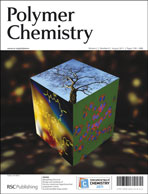Rare earth borohydride complexes are known as efficient initiators for the polymerization of both apolar and polar monomers. Significant contribution of the phosphiniminomethanide ligand on the reactivity of group 3 derivatives was previously established in the polymerization of ε-caprolactone. Investigations of the capability of bis(phosphinimino)methanide rare earth metal bisborohydrides, [{CH(PPh2NSiMe3)2}La(BH4)2(THF)] (1) and [{CH(PPh2NSiMe3)2}Ln(BH4)2] (Ln = Y (2), Lu (3)) to polymerize methyl methacrylate (MMA) both experimentally and computationally, are reported here. All three metallic compounds allowed the preparation of PMMA at room temperature. However, the overall performances of 1–3 remain quite poor based on experimental observations. DFT investigations on the insertion of the first two MMA molecules revealed that the incoming of the first MMA molecule was the most important step regardless of the nature of the metal center. The nucleophilic attack of MMA leads to the formation of a first adduct B followed by the unprecedented trapping of the liberated BH3 group by the nitrogen of the phosphiniminomethanide ligand to afford the active enolate species C. The unique significant role played by the phosphiniminomethanide ligand has thus been clearly unveiled and evidenced computationally. This whole first insertion of the MMA process is both kinetically and thermodynamically favorable. Trapping of the BH3 by the ancillary ligand appeared to make the second MMA insertion more energetically favorable than the first one, especially for lanthanum. The ketoenolate thus formed, Prod., is thermodynamically and kinetically favorable. In the case of yttrium, steric considerations, in addition to energetically comparable first and second MMA insertions, support the experimentally observed difficulty to polymerize MMA. DFT calculations closely corroborate experimental findings.

You have access to this article
 Please wait while we load your content...
Something went wrong. Try again?
Please wait while we load your content...
Something went wrong. Try again?


 Please wait while we load your content...
Please wait while we load your content...